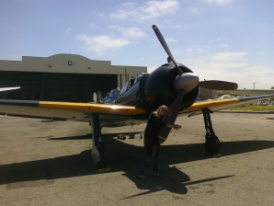Some of you know that I recently went back to America during part of summer vacation. While I was in Los Angeles, my friend Worm (it’s a nickname, don’t ask) was kind enough to take me up to see the Southern Wing of the Commemorative Air Force (CAF) at Camarillo Airport where he volunteers as a pilot. The CAF is a completely volunteer-run non-profit that restores and flies military aircraft – primarily WWII aircraft. Though the United States produced over 300,000 aircraft during the Second World War, almost none remained by 1960. Now, the CAF holds nearly 160 aircraft (60 different types) in various locations across the United States. The fleet includes aircraft from several different countries and aircraft from conflicts since WWII.
The CAF defines their mission as:
The CAF was founded to acquire, restore and preserve in flying condition a complete collection of combat aircraft which were flown by all military services of the United States, and selected aircraft of other nations, for the education and enjoyment of present and future generations of Americans.
More than just a collection of airworthy warplanes from the past, the CAF’s fleet of historic aircraft, known as the CAF Ghost Squadron, recreate, remind and reinforce the lessons learned from the defining moments in American military aviation history.
The CAF travels internationally to hold educational exhibitions and perform air shows. The Southern California Wing of the CAF sports a ridiculously impressive collection of aircraft –
- Grumman F-8F Bearcat, N7825C – Flying
North American SNJ-5 Texan, N89014 – Flying
Grumman F6F-5 Hellcat, N1078Z – Flying
Mitsubishi A6M3 Zero, Model 22, N712Z – Flying
Fairchild PT-19 Cornell, N641BP – Flying
North American SNJ-4 Texan, N6411D – In restoration
Curtiss C-46, China Doll, N53594 – In restoration
North American B-25 Mitchell, N5865V – In restoration
Supermarine Mark XiV Spitfire, N749DP – In restoration
 Obviously, I consider the Mitsubishi A6M3 ‘Zero’ to be the crown jewel of their collection. It has been completely restored and it is ONE OF ONLY THREE FLYABLE ZEROS IN THE WORLD. Because Worm is currently being groomed as the Zero’s new pilot, I got to crawl all over the damn thing.
Obviously, I consider the Mitsubishi A6M3 ‘Zero’ to be the crown jewel of their collection. It has been completely restored and it is ONE OF ONLY THREE FLYABLE ZEROS IN THE WORLD. Because Worm is currently being groomed as the Zero’s new pilot, I got to crawl all over the damn thing.
For WWII history buffs, the Zero has acquired an almost mythic reputation. I would argue that its silhouette is THE most recognizable of any WWII aircraft. No one can forget the images of Zeros flying over Pearl Harbor…even if it was a short clip from high school US History class or the images from Michael Bay’s atrocious Pearl Harbor (2001).
Picture Constantine having a history orgasm in the middle of an airstrip in SoCal and you’ll have a good idea of how excited I was.
The Zero was arguably the best carrier-based fighter during WWII, with a maneuverability and range that repeatedly devastated US fighters in dogfights during the early years of the Pacific conflict (especially considering the out-dated equipment that the US was using during 1941). By 1942-1943, however, an improvement in US equipment and tactics undermined the Zero’s ability to hold its own against the US military-industrial machine.
The Model 22 Zero at the SoCal CAF is not the model that was used during the attack on Pearl Harbor. The A6M3 Type 0 Model 22 (零式艦上戦闘機二二型) was produced between December 1942 and summer of 1943. It’s sports a new version of the Model 21’s longer folding wings, a more powerful engine and the longest range of all the Zeros. 560 Model 22s were produced.
To give you an idea of how rare the Zero is – the epic 1970 film Tora! Tora! Tora! (and most film and TV productions) use modified and repainted t-6 Texans. Only one Model 52 was used during the production of Bay’s Pearl Harbor.
Worm and some of the awesome men at the CAF explained to me that the Zero possessed maneuverability, speed and firepower at the expense of protection. There is only one small armor plate behind the cockpit that would do very little to protect the pilot. In contrast, American-built fighters had large amounts of armor plating, which protected the pilots at the expense of weight, maneuverability and speed. Comparing the planes up close, the Zero is absolutely dwarfed by the formidable Grumman F6F-5 Hellcat. One of the pilots ironically described the Zero’s construction as ‘chintzy’ and, indeed, there are large square areas on the Zero’s wings that you must avoid putting any weight on because of the thin metal. But this, too, speaks to the Zero’s efficiency as a carrier-based fighter.
Now for some orgasm worthy pictures (not great quality):
I was also happy to see the P-51 Mustang, complete with a Nazi death count on its side.
I was exceedingly lucky because the CAF were in the process of getting all the WWII aircraft ready for an airshow at a nearby naval base. I therefore got to watch a whole slew of aircraft – including the Zero – take off and fly away in formation. You, readers, are unlucky because I forgot to bring my camera and capture it all on film for you. Better luck next time!
I can honestly say that I would move to LA just to have the opportunity to volunteer at the SoCal CAF and drool over WWII planes (and veterans…and pilots…and Worm) on a regular basis.
For more information:
The CAF Southern California Wing – http://www.cafsocal.com/
The CAF Official Homepage – http://commemorativeairforce.org/








Recent Comments